Widow's cap facts for kids
A widow's cap (also called a mourning cap) was a special hat worn by women in the 1800s after their husbands passed away. It was a clear sign of mourning and showed how important their religion and social standing were. Women wore these caps throughout the first period of mourning during the Victorian era.
History of Mourning Caps
A famous example of deep mourning was Queen Victoria. Her husband, Prince Albert, died on December 14, 1861, from typhoid. After his death, Queen Victoria wore mourning clothes for over forty years, until she died in 1901.
She mourned deeply for three years and made her entire royal court dress in the same way. The Queen's actions made the traditions of public mourning even stronger during the Victorian era.
Victorian mourning fashion was especially important for women, particularly widows. These special clothes helped show a widow's social position. Wearing the right mourning clothes was the main way to show how wealthy and respected a woman was in society.
Materials for Mourning Caps
A Victorian mourning cap was usually black or a very dark color. The exact shade depended on how recently the woman had lost her husband. The newer the loss, the simpler the cap's design.
The shape of the cap often depended on the widow's age. However, the most common style had a peak at the front.
Widows' caps were made from light fabrics like lisse, tulle, or tarlatan. Young widows often wore a style called the Mary Stuart cap. All widows' caps had long streamers hanging from them.
The prices of these caps varied. Caps made from tarlatan could be made at home. However, many widows preferred to buy their caps. Home-made caps, even if they saved money, often wore out faster than store-bought ones. It was a good idea to buy extra streamers and bows because they could be used to decorate mourning caps at home.
The Mary Stuart Cap Style
The Mary Stuart cap, also known as an attifet, is a type of hat that became well-known during the Elizabethan era. It often appeared in portraits of Mary, Queen of Scots. This unique cap style became quite popular for a short time. It even became part of formal mourning clothes until the Victorian era.
A classic Mary Stuart cap fits very tightly. It has a solid, triangular piece of fabric that hangs over the forehead. When seen from the front, this creates a heart shape. This design was made to hold a veil, which was usually worn over the cap. The material might be rolled into shape at the back or held firmly with wires. The cap also curved slightly at the sides to fit around rolls of hair.



